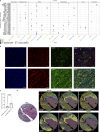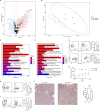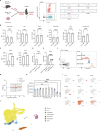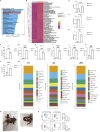An iron-rich subset of macrophages promotes tumor growth through a Bach1-Ednrb axis
- PMID: 39347789
- PMCID: PMC11457473
- DOI: 10.1084/jem.20230420
An iron-rich subset of macrophages promotes tumor growth through a Bach1-Ednrb axis
Abstract
We define a subset of macrophages in the tumor microenvironment characterized by high intracellular iron and enrichment of heme and iron metabolism genes. These iron-rich tumor-associated macrophages (iTAMs) supported angiogenesis and immunosuppression in the tumor microenvironment and were conserved between mice and humans. iTAMs comprise two additional subsets based on gene expression profile and location-perivascular (pviTAM) and stromal (stiTAM). We identified the endothelin receptor type B (Ednrb) as a specific marker of iTAMs and found myeloid-specific deletion of Ednrb to reduce tumor growth and vascular density. Further studies identified the transcription factor Bach1 as a repressor of the iTAM transcriptional program, including Ednrb expression. Heme is a known inhibitor of Bach1, and, correspondingly, heme exposure induced Ednrb and iTAM signature genes in macrophages. Thus, iTAMs are a distinct macrophage subset regulated by the transcription factor Bach1 and characterized by Ednrb-mediated immunosuppressive and angiogenic functions.
© 2024 Folkert et al.
Conflict of interest statement
Disclosures: K. Rai reported personal fees from Daiichi Sankyo, other from Jivanu Therapeutics, and other from Koshika Therapeutics outside the submitted work. No other disclosures were reported.
Figures















References
-
- Arlauckas, S.P., Garris C.S., Kohler R.H., Kitaoka M., Cuccarese M.F., Yang K.S., Miller M.A., Carlson J.C., Freeman G.J., Anthony R.M., et al. . 2017. In vivo imaging reveals a tumor-associated macrophage-mediated resistance pathway in anti-PD-1 therapy. Sci. Transl. Med. 9:eaal3604. 10.1126/scitranslmed.aal3604 - DOI - PMC - PubMed
-
- Askenase, M.H., Goods B.A., Beatty H.E., Steinschneider A.F., Velazquez S.E., Osherov A., Landreneau M.J., Carroll S.L., Tran T.B., Avram V.S., et al. . 2021. Longitudinal transcriptomics define the stages of myeloid activation in the living human brain after intracerebral hemorrhage. Sci. Immunol. 6:eabd6279. 10.1126/sciimmunol.abd6279 - DOI - PMC - PubMed
-
- Benci, J.L., Xu B., Qiu Y., Wu T.J., Dada H., Twyman-Saint Victor C., Cucolo L., Lee D.S.M., Pauken K.E., Huang A.C., et al. . 2016. Tumor interferon signaling regulates a multigenic resistance program to immune checkpoint blockade. Cell. 167:1540–1554.e12. 10.1016/j.cell.2016.11.022 - DOI - PMC - PubMed
MeSH terms
Substances
Grants and funding
LinkOut - more resources
Full Text Sources
Medical
Molecular Biology Databases
Research Materials
Miscellaneous

